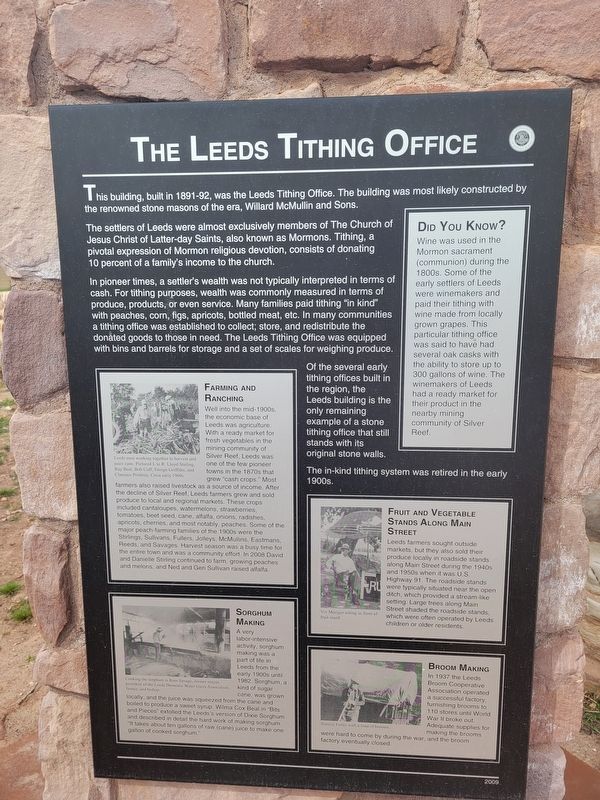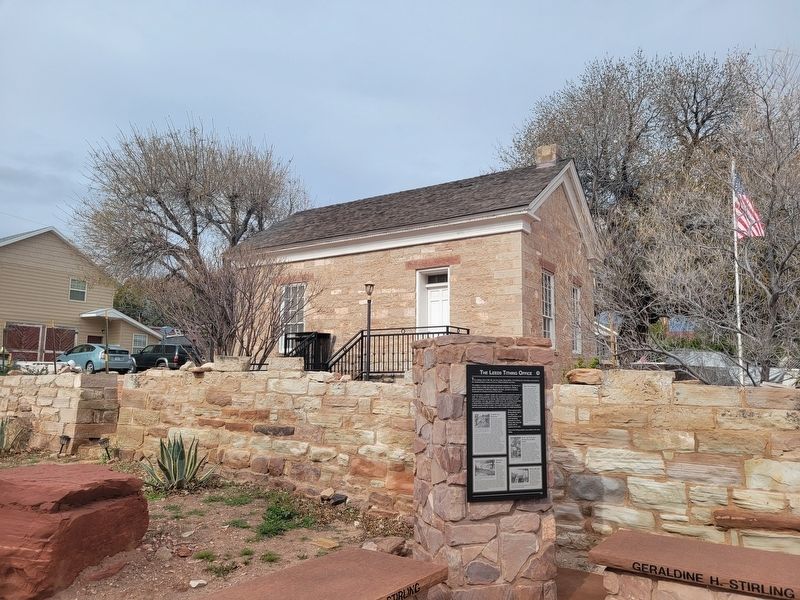Leeds in Washington County, Utah — The American Mountains (Southwest)
The Leeds Tithing Office
This building, built in 1891-92, was the Leeds Tithing Office. The building was most likely constructed by the renowned stone masons of the era, Willard McMullin and Sons.
The settlers of Leeds were almost exclusively members of The Church of Jesus Christ of Latter-day Saints, also known as Mormons. Tithing, a pivotal expression of Mormon religious devotion, consists of donating 10 percent of a family's income to the church.
In pioneer times, a settler's wealth was not typically interpreted in terms of cash. For tithing purposes, wealth was commonly measured in terms of produce, products, or even service. Many families paid tithing "in kind" with peaches, corn, figs, apricots, bottled meat, etc. In many communities a tithing office was established to collect, store, and redistribute the donated goods to those in need. The Leeds Tithing Office was equipped with bins and barrels for storage and a set of scales for weighing produce.
Of the several early tithing offices built in the region, the Leeds building is the only remaining example of a stone tithing office that still stands with its original stone walls.
The in-kind tithing system was retired in the early 1900s.
Farming and Ranching
Well into the mid-1900s the economic base of Leeds was agriculture With a ready market for fresh vegetables in the mining community of Silver Reef, Leeds was one of the few pioneer towns in the 1870s that grew "cash crops." Most farmers also raised livestock as a source of income. After the decline of Silver Reel Leeds farmers grew and sold produce to local and regional markets. These crops ncluded cantaloupes, watermelons, strawbees tomatoes, beed seed cane, atata onions, radashes apricots, cherries and most notably, peaches. Some of the major peach farming families of the 1900s were the Strings, Sullivans Fulers Joeys, McMullins, Eastmans, Reeds and Savages. Harvest season was a busy time for the entire town and was a community effort In 2008 David and Daniele String continued to farm growing peaches and melons and Ned and Geri Sullivan raised alfalfa.
Fruit and Vegetable Stands Along Main Street
Leeds farmers sought outside markets, but they also sold their produce locally in roadside stands along Main Street during the 1940s and 1950s when it was US Highway 91. The roadside stands were typically situated near the open ditch, which provided a stream-like setting. Large trees along Main Street shaded the roadside stands which were often operated by Leeds children or older residents.
Sorghum Making
A very labor-intensive activity, sorghum making was a part of life in Leeds from the early 1900s until 1982 Sorghum, a kind of sugar cane was grown socially and the juice was squeezed from the cane and boiled to produce a sweet syrup. Wilma Cox Beal in "Bits and Pieces" extolled the Leeds's version of Dixie Sorghum and described in detail the hard work of making sorghum. "It takes about ten gallons of raw(cane) juice to make one gallon of cooked sorghum."
Broom Making
In 1937 the Leeds Broom Cooperative Association operated a successful factory, furnishing brooms to 110 stores until World War II broke out. Adequate supplies for making the brooms were hard to come by during the war, and the broom factory eventually closed.
Did you know?
Wine was used in the Mormon sacrament (communion) during the 1800s. Some of the early settlers of Leeds were winemakers and paid their tithing with wine made from locally grown grapes. This particular tithing office was said to have had several oak casks with the ability to store up to 300 gallons of wine. The winemakers of Leeds had a ready market for their product in the nearby mining community of Silver Reef.
Erected 2009.
Topics. This historical marker is listed in these topic lists: Agriculture • Churches & Religion • Industry & Commerce • Settlements & Settlers. A significant historical year for this entry is 1891.
Location. 37° 14.166′ N, 113° 21.784′ W. Marker is in Leeds, Utah, in Washington County. Marker is at the intersection of Center Street and Main Street, on the right when traveling south on Center Street. Touch for map. Marker is at or near this postal address: 48 W Center Street, Leeds UT 84746, United States of America. Touch for directions.
Other nearby markers. At least 8 other markers are within walking distance of this marker. From Native American Trail to Interstate Exit (a few steps from this marker); Water Is Life...The Shovel Is Divine (within shouting distance of this marker); The Sarah Ann and William Stirling Home (within shouting distance of this marker); Leeds CCC Camp (approx. ¼ mile away); Leeds Historic CCC Camp (approx. ¼ mile away); Civilian Conservation Corps, Leeds, Utah (approx. ¼ mile away); "They Were Poor, Hungry, and They Built to Last" (approx. ¼ mile away); From Schoolhouse to Town Hall (approx. 0.3 miles away). Touch for a list and map of all markers in Leeds.
Credits. This page was last revised on March 22, 2024. It was originally submitted on March 17, 2024, by Jeremy Snow of Cedar City, Utah. This page has been viewed 42 times since then. Photos: 1, 2. submitted on March 17, 2024, by Jeremy Snow of Cedar City, Utah. • Andrew Ruppenstein was the editor who published this page.

